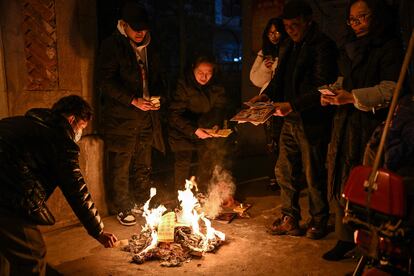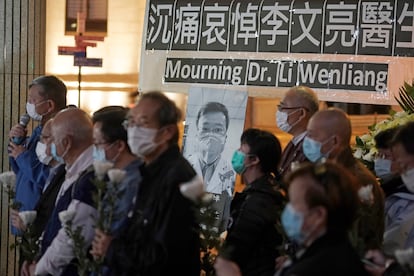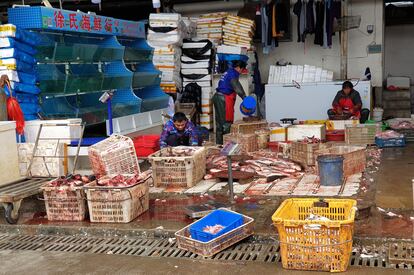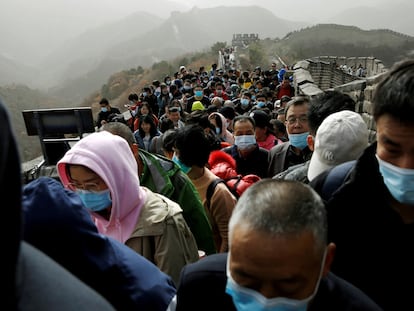Wuhan, three years after Covid confinement: ‘It’s like my life has been locked down’
A portrait of the Chinese city that registered the first cases of coronavirus and whose residents were subjected to strict controls ahead of the rest of the world

A loud, energetic lady has just been cutting fish and is now washing her cracked hands. She eats from a bowl with chopsticks and explains that business is bad; people have no money after the lockdowns. Behind her, a huge spider crab, costing the equivalent of $79 or €73 a kilo, throws its legs over the side of the fish tank in a bid to escape its fate. The stall is located at a new site for fresh produce vendors in the north of Wuhan. It used to be in the Huanan market, the place where the first cases of an unknown, highly contagious virus were reported in late 2019, and that spread around the world at unprecedented speed causing at least 6.7 million deaths and a global health emergency which continues to cast its long shadow over our lives. As soon as Covid is mentioned, the woman clams up. “I’m not supposed to talk to foreigners,” she says.
In Wuhan, the pandemic is still a sensitive topic. After the first cases came to light, the Huanan market was immediately closed and surrounded by men in bio-protective white suits – a surreal image that later spread across the world. The markets’ vendors were moved; some ended up in two markets in the north of the city. After several vendors alerted security, EL PAÍS was asked to leave the premises of the second one, where dozens of open-air stalls sell seafood, fish and even live reptiles, such as softshell turtles.

The Huanan market has never been reopened, despite the fact that investigators from the World Health Organization (WHO) downgraded its role as a possible source of the pandemic after their visit in 2021. It is now fenced off, but still stands next to a block of apartments, like a scar, lingering behind faded blue tarpaulin crowned by a spiral of what looks like concertina wire. You probably wouldn’t even notice it if you walked past. It is curious how quickly these footprints of disaster fade into obscurity.
After the virus was detected, events moved at breakneck speed. On December 31, 2019, China informed the WHO of cases of a pneumonia with no known cause in Wuhan, capital of Hubei province. The Huanan market, where live fish and seafood are sold, was closed for disinfection on January 1, 2020. On January 3, authorities reported 44 cases, 11 of whom were seriously ill. On January 11, the first death was recorded. On January 13, a case was confirmed in Thailand, the first to be detected abroad. On January 14, the WHO stated that “it would not be surprising” if the virus could be passed between humans. On January 20, Beijing confirmed human-to-human transmission. Three days later, on January 23, authorities decided to lock down Wuhan, a city of 11 million inhabitants, to the astonishment of the rest of humanity.
January 23, 2023, marks three years since the first lockdown that lasted 76 days and left an indelible scar on its inhabitants. “No one who is not in Wuhan can understand what those of us who are in the city are going through,” says Fang Fang, 67, an author who kept a record of the lockdown, which she posted on the internet and was read by tens of millions of people every day, later to be published as Wuhan Diary: Dispatches from a Quarantined City. In it, she vented her anger at the fact that things could have been done differently, avoiding “devastating” damage, if only the authorities had not insisted on “giving only positive news and hiding bad news, preventing people from telling the truth.”
“We Wuhan residents are in desperate need of comfort,” the ophthalmologist Li Wenliang wrote just before he died of Covid. Wenliang was one of the first local doctors to raise the alarm before there was any official recognition of the virus by the authorities, earning him a reprimand for spreading rumors. “Li Wenliang was just like any of us; he was one of us,” says Fang Fang.

Three years later, Fang Fang keeps to her home in Wuhan. After suddenly lifting the anti-pandemic restrictions in December after more than 1,000 days, China has been subject to a Covid tsunami that has left tens of thousands dead. Unvaccinated, with diabetes and a heart condition, Fang Fang fears she will catch the virus – in China, vaccination has lagged behind other places, especially among the elderly and vulnerable. “In the last month, many friends and relatives around me have died from the infection, which is distressing,” she tells EL PAÍS.
Fang Fang says she is “totally opposed to the massive testing and continued expansion of lockdowns” that the country has been subjected to in recent times. The practices of “confinement and control,” have, she says, in many cases departed “from reason and common sense. Lifting the lockdown was essential.” But she also believes that the country was unprepared for the sudden change of policy regarding the restrictions, which, given the cold of winter, has brought about a tragic outcome. “Many people have died this January through lack of medicines,” she says. Hospitals have been overwhelmed. Crematoriums have been unable to dispose of all the bodies. “There have been deaths everywhere. It has been deplorable.” However, Fang Fang also says that many of those infected have recovered: “They are starting to go out and the streets have almost got back to normal.”
In Wuhan, as in the rest of China, the recent wave of Covid has spread like wildfire. A Peking University study estimates that in just over a month some 900 million people, almost two-thirds of the country, have been infected. Most of those interviewed said they were infected in December. But in the days leading up to the Lunar New Year on January 22, the city is buzzing, restaurants are packed and the sound of fireworks can be heard everywhere. It is the first time in three years that the most important holiday on the Chinese calendar can be celebrated with abandon.
But these past three years have been long and hard. “It’s like my life has been locked down,” says Jessica Wang, the pseudonym of a 29-year-old from Wuhan who has lived through the continuous lockdowns and policy changes. She feels that neither her life nor her career has moved forward during this time. “I’ve been stuck,” she says. As owners of restaurants and hotels, her family has been battered by the economic fallout, though they have been hired by the authorities to supply hospitals with food and provide shelter to positive cases in quarantine.
Wang’s father became ill with Covid during the recent wave and had to be admitted to hospital where there were few beds or drugs available. His daughter was forced to search high and low for immunoglobulin, she says. She ended up paying the equivalent of €5,700 for a week’s treatment, plus the bed, which came to just over €1,300. Her father survived, despite not being vaccinated. “It’s because of his diabetes,” says Wang, who gives the feeling that she senses something doesn’t add up. “We’ve been following the rules for three years, and now we have to suffer – what’s been the point of it all? Asked if she thinks things will improve this year, she says: “No, I don’t think so.”
Everyone has their own story concerning the past three years. An artist in his 50s says it has been a “blank period” that has left him “numb,” robbing him of the urge to work. He describes the QR codes – the high-tech surveillance system implemented by the authorities – as a labyrinth. “An advanced and very modern technology, but used by pre-modern leaders,” he says. Though he himself didn’t protest at the end of November due to his family situation, he admires those who did and feels “optimistic” about 2023.
After our interview, this artist received a call from the authorities asking him about his meeting with a reporter from a foreign media outlet. Another interviewee received a call from the authorities while the interview was actually taking place – an interview in which the central question was precisely how Beijing has increased its level of surveillance over the past three years. This interviewee recalled a surreal moment when all the residents of an apartment building were lining up for a PCR test “as if they were corpses in a science fiction movie, following the instructions of the government. It was scary.”
“The impact has been huge,” says Zhu Ning, 51, owner of a small music venue linked to the punk scene, which has managed to survive by running a music school and renting rehearsal space. “If there are no shows, there is no income,” he adds. The venue used to schedule about 200 concerts a year. In 2020, there were around 40. In 2021, they managed to hike that to 120. Zhu says they haven’t even calculated the number in 2022. “It sucked,” he says, adding that he hasn’t noticed Covid’s impact reflected in the lyrics of the bands, though of course there is an explanation for this: “Anything sung has to be approved by the authorities,” he explains. Zhu believes that perhaps it will be reflected in the future. He is also optimistic about 2023. But he believes it will take several years to claw back what has been lost.
Meanwhile, Carrie, 26, says it has been a good three years for her overall. She finished her degree at an Australian university, which she studied remotely from Wuhan. She has had a university job, and has also sold clothes on Douyin – China’s name for TikTok. She is now employed at an investment firm and continues to load content onto a sports video channel. She does, however, acknowledge that, for many, the past three years have been tough, physically, mentally and financially. “We’re definitely in another phase,” she says, glancing around the crowded restaurant. “There’s new hope.” Towards the end of the conversation, she states flatly that it was the Americans who brought the virus to the city during the Military Olympics held in Wuhan in October 2019.
This unsubstantiated theory was floated in 2020 by Zhao Lijian, then a spokesman for the Chinese Foreign Ministry, who tweeted, “When did patient zero begin in US? How many people are infected? What are the names of the hospitals? It might be US army who brought the epidemic to Wuhan. Be transparent! Make public your data! US owe us an explanation!” Carrie believes that the dominant power in the coming years will be the one to determine the origins of the pandemic.

“Now everyone is happy,” says a local at an alcohol and tobacco store located across the street from Leishenshan Hospital, one of two that were thrown up quickly in Wuhan to cope with the pandemic. The hospital is another of the city’s Covid scars. It now appears abandoned; behind the gate, the ground is burgeoning with weeds and several buildings appear to be propped up. The local, who lives in the buildings across the street, is happy to share a cigarette, tea and a chat. He says that there is a project to demolish the hospital and convert it into housing. “We feel optimistic about 2023,” he says. For the first time in three years, he is going to join his family for New Year. He is confident that foreigners will return, bringing money. And he also asks, “Do you think Covid-19 was created by the Americans?”
Sign up for our weekly newsletter to get more English-language news coverage from EL PAÍS USA Edition
Tu suscripción se está usando en otro dispositivo
¿Quieres añadir otro usuario a tu suscripción?
Si continúas leyendo en este dispositivo, no se podrá leer en el otro.
FlechaTu suscripción se está usando en otro dispositivo y solo puedes acceder a EL PAÍS desde un dispositivo a la vez.
Si quieres compartir tu cuenta, cambia tu suscripción a la modalidad Premium, así podrás añadir otro usuario. Cada uno accederá con su propia cuenta de email, lo que os permitirá personalizar vuestra experiencia en EL PAÍS.
¿Tienes una suscripción de empresa? Accede aquí para contratar más cuentas.
En el caso de no saber quién está usando tu cuenta, te recomendamos cambiar tu contraseña aquí.
Si decides continuar compartiendo tu cuenta, este mensaje se mostrará en tu dispositivo y en el de la otra persona que está usando tu cuenta de forma indefinida, afectando a tu experiencia de lectura. Puedes consultar aquí los términos y condiciones de la suscripción digital.
More information
Archived In
Últimas noticias
David Bowie, the galactic thinker who encouraged us to break new ground
John Berger and the loss of rural culture
From police officer to bloodthirsty kidnapper: Terror in Mexico during the years of ‘The Ear Chopper’
Alain Aspect, Nobel laureate in physics: ‘Einstein was so smart that he would have had to recognize quantum entanglement’
Most viewed
- David King, chemist: ‘There are scientists studying how to cool the planet; nobody should stop these experiments from happening’
- Reinhard Genzel, Nobel laureate in physics: ‘One-minute videos will never give you the truth’
- Oona Chaplin: ‘I told James Cameron that I was living in a treehouse and starting a permaculture project with a friend’
- Mexico completes its trade shift with the entry into force of tariffs on China and countries without trade agreements
- Sinaloa Cartel war is taking its toll on Los Chapitos











































